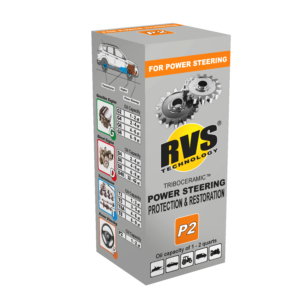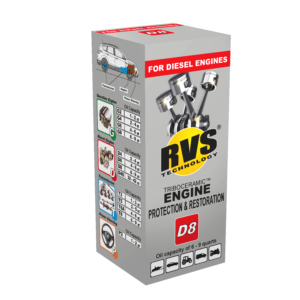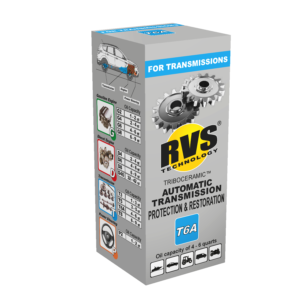Price range: $39.95 through $79.95
If your vehicle has a larger oil capacity, products can be combined. For example G4 and G6 can be combined to be used for a vehicle with an oil capacity of 10 quarts.
For vehicles that have over 25,000 miles, two treatments are highly recommended.
- One treatment lasts at least 60,000 miles (2500 hrs in machinery)
- Auto-reactive method
RVS Technology® is a technique that has the capacity to form a Triboceramic surface structure on metal friction contact zones (metal-ceramic), while the mechanism is in it’s normal productive operation. RVS has unique properties; it protects and prevents the surfaces and mechanisms of wear and tear. RVS is the only technology that has the ability to restore sliding surfaces, in good case, up to their original shape and tolerances. The new surface structure takes place autoreactively, without
disassembling the equipment being restored. In practice this means, without down times and loss of production.
The core of the technology is its ability to identify objects and points prone to wear and damage by “locating” the source of the thermal energy (heat) produced by the friction and it’s capacity to modify these friction surfaces. The process ceases automatically as the required result is obtained.
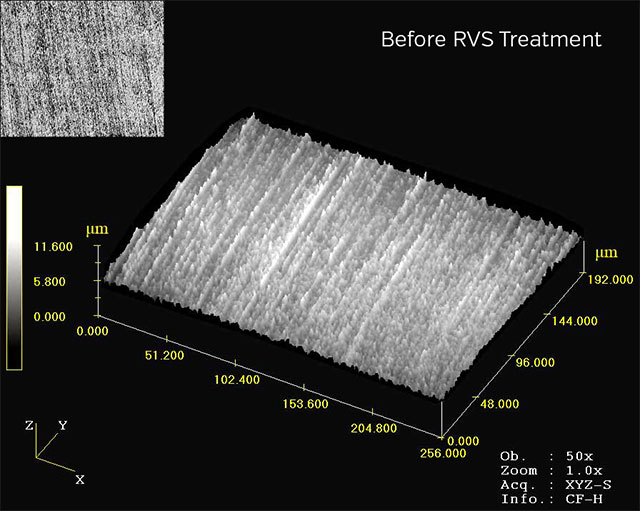
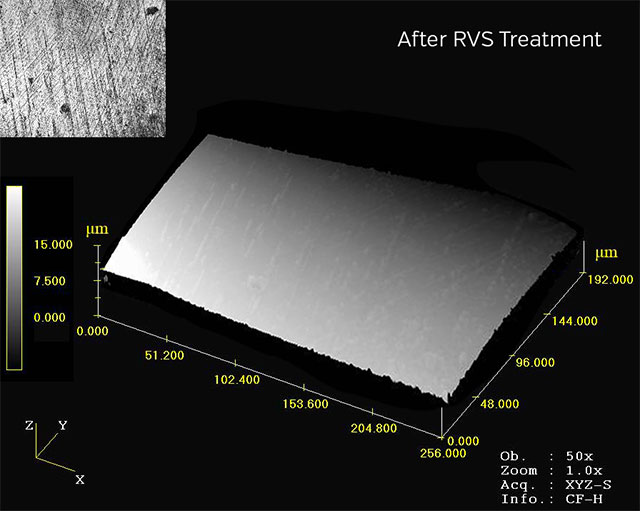
The thickness of the born structure depends on the wear rate and the hardness on the surface pressure during the process.
The clearances in every friction pair in the mechanism are optimised to a level hard to achieve by current application methods. All this takes place without down times and needs for expensive spare parts and costs of logistic, handling or remote processing. The result is a reliable mechanism for a long time.
- Takes place productively and automatically
- No disassembly, handling or remote processing
- No costly and time consuming Down Times
- Prolonges life cycle of components (30-70%)
- Reduces replacement demand of costly spareparts as wear process almost stops
- Reduces number of expensive down times and maintenance hours / days
- Improves predictability of mechanism function
- Reduces energy & fuel consumption (5-20%)
- Reduces emissions – Reduced environmental strain (10 – 50%)
- Reduces vibration & noise level (10-50%)
- Reduces need/Prolonges life cycle of lubricants (30-50%)
- Possibility to use less expensive lubricants with less additives
- Less corrosion problems
- Survival of the mechanism in case of accidental loss of lubricant!
- 5.1 oz (150 ml) of oil
- 0.37 oz (11 ml) of RVS gel
- Step-by-step instruction booklet in English, Spanish and French.
RVS Technology® Tribo(nano-)Ceramics can be considered as an advanced mode of cure for engines, gearboxes, and other mechanisms. If your device has normal wear problems like noise, smoking, too high consumption of oil or fuel, decrease of power and compression level, unbalance and vibrations RVS Technology has the capacity to restore it.
RVS Technology works also as a preventive method, protecting your mechanisms against coming wear. For example treatment of car parts will protect your car from serious problems in the future.
Restores Vital Surfaces
No! Unlike oil additives on the market, RVS Technology® products produce a nano-ceramic layer that integrates with the metal friction surfaces of your engine, transmission, differential etc. That’s why it lasts at least 60,000 miles (or 2500 hours in machinery) and oil changes do not affect it. RVS does not affect the properties of oil. The idea of oil additives is to improve the oil’s properties and have to be re-applied at every oil change.
Cold start is a phenomenon observed when an engine is started in cold weather – during the first few seconds, the oil is thick and oil pressure is low, and the engine is starved of oil – that causes parts inside to wear out due to the friction caused by lack of proper lubrication. The Triboceramic layer created by RVS Technology® protects the components inside an engine from this oil starvation because even without oil, the triboceramic layer is very slippery, thus minimizing the damage caused by cold starts.
No! Unlike oil additives on the market, RVS Technology® products produce a Triboceramic layer that integrates with the metal friction surfaces of your engine, transmission, differential etc. That’s why it lasts for 60,000 miles (100,000km) and oil changes do not affect it. The idea of oil additives is to improve the oil properties and have to be re-applied at every oil change.
No! As mentioned above, our products react directly with the metal components, forming a Triboceramic layer that is durable and that becomes an integral part of the metal components. Oil changes do not affect the RVS Technology® treatment.
Our products are categorized by the oil capacity of the device you are treating. If your engine holds 4 qts/liters of oil, you need a G4 treatment. If it holds 5, you need the next highest number – G6. An automatic transmission with 6 qts/liters of ATF needs a T6A, and so on. If you are unsure of the fluid capacities of your particular vehicle, they can usually be found in your owner’s manual, the link provided on our web page, or you can simply contact us and we will find it out for you!
Yes! Due to the lowered internal friction, the engine runs cooler after a RVS Technology® treatment. This can be beneficial in warm climates where vehicles are subjected to extreme heat.
Yes! RVS Technology® can definitely help. The low compression and lack of power are usually caused by worn out cylinder walls. The Triboceramic layer created by RVS Technology® seals the gaps and restores compression/power potentially saving you thousands.
Yes, it can! The reasons for high gas mileage can be numerous. Regardless of the reason, you will notice an improvement after a full RVS Technology® treatment. The reduced mechanical friction allows your engine to run more efficiently. The result is typically a 5-12% improvement in gas mileage, casewise even more.
Yes. RVS Technology® products are fully compatible with all types of oils.
If it’s caused by a valve problem RVS may help, but if the transmission slips because the clutches inside of it are worn out RVS cannot help. The clutches have paper-kind of mass surfaces and RVS Technology® works only on metal parts. Sometimes the problem is caused by bad shifter solenoids, which is an electrical problem, and this case they need to be repaired/replaced accordingly.
There are many metal gears, bearings, and valves as well as an oil pump inside automatic transmissions that benefit from the effects of an RVS Technology® treatment. Friction surfaces of these parts are treated and the friction between them is reduced, allowing your transmission to operate smoother and quieter. Internal heat production that burns the oil and is the main cause for transmission failure is reduced, extending the life of the oil and transmission itself.
The oil capacity is comparatively easy to find out for your vehicle, and normally it defines sufficiently well how much area there is to treat in the mechanism. Thus it is important to choose the right RVS product for your exact application and therefore guaranteeing there is enough of it to perform the restorative and protective functions as designed.
In industrial applications with external oil tanks and relatively low flow speed, other criteria are used for calculating the appropriate RVS Technology™ product amount.
In treating mechanisms, you usually use the lubricant (oil) used in the mechanism as a carrier that delivers the RVS gel to its destination. In the simplest cases, you just pour the RVS gel into the device and use it as usual for a certain period of time. See detailed application instructions for different types of RVS Technology® products on the product page under different product groups. To apply RVS Technology® products in industrial equipment, contact us for instructions.
Neither way is wrong. In new or almost new engines it doesn’t even make a big difference when it is performed due to not having many contaminants yet.
The higher the mileage, the dirtier the engine internals usually are. During the treatment procedure, dirt is removed from the surfaces and it gets to the oil. That’s why it is often recommendable to change the oil before the second treatment that we recommend for engines with mileage higher than 25,000 miles (40,000 km) Therefore the most optimal time for starting the RVS Technology® treatment procedures with a used engine is about 250 miles (400 km) before a scheduled oil change. The second treatment is then carried out after the oil change, and the RVS Technology® substance can be left in the engine until the following regular oil change.
Yes! RVS Technology creates a triboceramic surface on friction pairs, both surfaces of which are metallic. The clutch pack is made up of a stack of alternating steel plates and friction plates that create the clutch pack. These alternating plate surfaces create the friction between them. RVS only reacts with the metallic plate, and does not create new surface on the friction plate, creating no problems with the friction.
What actually happens is that RVS creates a triboceramic surface on the wearing metal friction surfaces. This creates less mechanic drag, and axial movement of the clutch is easier, which makes the clutch work smoother and better. Additionally, the metal plates surfaces become “smoother” hence actually increasing the surface area of the metal plate against the friction plate. The transmission has many moving gears and shafts, and those additionally greatly benefit from the RVS Triboceramic coating. It is recommended to use a slightly stronger product for motorcycles due to this fact. For example if your motorcycle has an oil capacity of 4 quarts, use a G6 product instead of a G4.
Yes, they can. When at least one of the surfaces is made of material other than metal the RVS substance does not react and it does not affect the non-metal surfaces in any way.
Yes, they can! The active substance in RVS Technology products does not react with ethanol in any way.
Furthermore, using RVS in ethanol engines is even more recommended than in gasoline engines as the lubricating properties of ethanol are worse than those of gasoline, which, in turn, makes wearing processes more intensive. When entering lubricants, ethanol reduces their properties more than gasoline does, and, with triboceramic surface, the extra wear can be prevented.
No! The RVS Technology products are designed to safely be added to your engines/mechanisms existing lubricant (oil). Since RVS is not an oil additive, it will have lasting effects even after the oil is changed at a later date.
Part 1
Part 2
Part 3
If the vehicle has over 25,000 miles it is recommended to perform two treatments for best results. It is recommended to change the oil after 200-250 miles if a treatment is performed in a high mileage vehicle so the removed contaminants do not start circulating and adhering to the engine again.
Drive the vehicle as usual for approximately 200–250 miles (300–400 km) but avoid heavy engine loading (run-in).
Pour the rest of the mixture in the bottle into the engine.
 DOWNLOAD INSTRUCTION MANUAL
DOWNLOAD INSTRUCTION MANUAL
Step 01
Warm the engine up to its normal operating temperature. Meanwhile squeeze the contents of the small tube into the bottle and close the cap of the bottle and Shake the bottle well (20–30 sec.) until the mixture is homogeneous (The contents of the package should be at room temperature).
Step 02
Pour immediately half of the mixture into the engine and Let the engine idle for 15 minutes.
Step 03
Stop the engine for one minute.
Step 04
Shake the bottle well (20–30 sec.) and Pour the rest of the mixture in the bottle into the engine.
Drive the vehicle at least for 30 minutes avoiding heavy engine loading. When treating a motorcycle engine with united lubrication with the gearbox, use all the gears for equal intervals during this stage.
Drive the vehicle as usual for approximately 200–250 miles (300–400 kms) but avoid heavy engine loading (run-in).
If your engine life has more than 25,000 miles or 800 hours it is recommended that you perform a 2nd treatment. It is recommended not to postpone the second
treatment further as the dirt removed from the surfaces being treated starts to stick back on the cleaned surfaces.
The 2nd treatment is applied the same way as the 1st treatment.
The treatment is complete after approximately 1000–1250 miles (1500–2000 km) or 20 to 50 engine hours, counted from the start of second treatment.
A third treatment with a third package carried out similarly to the first and second ones may be useful for very worn engines.


